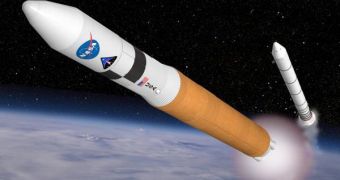The new spaceship currently under development at NASA, Ares V, will be able to transport people on the Moon and maybe even on Mars. A scientist is proposing a new type of rocket that, if mounted on Ares V, could dramatically reduce the costs of future manned missions.
Steven Howe, director of the Center for Space Nuclear Research (CSNR) at the Idaho National Laboratory in Idaho Falls, US, said that nuclear rockets will not only be more efficient in design, but will also reduce the costs of these missions, saving NASA billions of dollars.
A study presented by the institute, which funded four universities that actually devised it, proposes to replace the chemical rockets currently used and incorporating nuclear power into the new spacecraft, which could deliver people and parts for a lunar base, to the Moon.
A nuclear thermal rocket uses a fluid, like hydrogen, which is heated in a high temperature nuclear reactor and is then expanded through a rocket nozzle to create thrust. The energy given off by the nuclear reactor replaces the chemical energy of the reactive chemicals in a traditional rocket engine.
The study envisioned the Ares V using the chemical rockets to launch from Earth into orbit, where it would dock with the new Orion spacecraft, previously launched on an ordinary Ares I rocket. Then, a nuclear powered Ares V will come online, propelling the ship to the Moon.
In the 1960s, NASA experimented with nuclear thermal rockets, during a project called NERVA, Nuclear Engine for Rocket Vehicle Application that they planned to mount on the Saturn V, which would have become much more powerful and would eventually have launched interplanetary payloads.
The program was canceled in 1972, but current designs are far more effective than earlier versions and could perform the same task, being capable of delivering 29 tonnes of cargo to the Moon, instead of the 21 tonnes, the current upper limit.
Although NASA did not disclose the actual cost of each launch, Howe estimates total savings of $4.5 billion, using this nuclear rocket.

 14 DAY TRIAL //
14 DAY TRIAL //